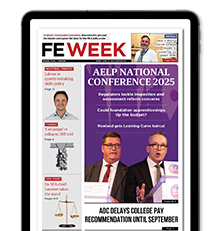Recruitment demand in colleges is bouncing back. We have seen a year-on-year increase in the number of roles we are working on across every region of the country. And colleges are placing a huge emphasis on the quality of staffing, ensuring that the educators – who are the foundation of their establishments – are not just meeting the standards of quality but also exceeding them.
When seeking to find solutions, it’s vital to shine a light on the difficulty colleges face with staffing.
Geography determines demand. Inner-city colleges have access to more candidates and therefore more sessional candidates. Rural colleges are more likely to recruit on a permanent basis as they are fishing in a smaller pond and therefore need to offer competitive packages to secure their candidates.
In my experience the strategic approaches that colleges can take to combat staffing issues revolve around these five areas:
1. Ensure dedicated ‘on-site’ recruitment
One of the most effective ways to tackle recruitment challenges is by introducing on-site recruitment solutions. By embedding dedicated recruiters within college teams, this approach offers institutions tailored, hands-on support to streamline recruitment processes. Rather than juggling multiple agencies, a single recruitment partner can provide consistency, efficiency, and expertise, leading to faster fill rates and a better overall candidate experience.
An embedded model ensures that recruitment aligns with the college’s unique needs and values. When recruiters are deeply embedded in an institution’s culture and long-term goals, they can better assess candidate fit, reducing mismatches and lowering turnover.
2. Focus on staff development and career progression
Retention is not just about offering competitive salaries – it’s also about investing in staff development. A key factor in preventing turnover is ensuring that staff feel supported and valued.
Tailored CPD (Continuing Professional Development) opportunities, career progression pathways, and a supportive work environment all contribute to retention. Colleges that invest in their staff’s growth are more likely to foster loyalty and reduce burnout.
3. Implement employee assistance programmes (EAPs)
Another cost-effective strategy to improve staff retention is the implementation of EAPs. These offer a range of support services, including mental health counselling, financial advice, and stress management resources.
While the upfront costs may be modest, the long-term benefits are substantial. By improving employee wellbeing, colleges can enhance morale, reduce absenteeism, and increase retention rates.
4. Use data-driven hiring
The use of AI and data-driven recruitment platforms can significantly improve hiring accuracy and reduce costs. By leveraging data to assess candidates’ suitability based on a range of factors – skills, experience, and cultural fit – colleges can make smarter, more informed hiring decisions. This approach reduces the chances of hiring mismatches, lowering turnover and the associated financial costs.
5. Collaborate with industry
Finally, forming partnerships with local businesses and industry leaders can help colleges build robust talent pipelines. By working together to create apprenticeships, shared teaching roles, and other collaborative initiatives, colleges can expand their recruitment base while reducing costs.
By adopting these strategies, colleges can create a workforce equipped to meet the evolving needs of students and institutions alike.

















Fixed prices and lengthened supply chains rarely work as each link in the chain needs a margin.
Take teaching staff for instance (same applies to NHS). You have funding constraints and because wages have not kept pace with inflation, living standards have fallen, people become demotivated and workforce churn increases.
Because of the funding constraints, decision-makers take a short-termist approach, in many cases relying on recruitment consultants & temp agencies (who need to make a margin) or golden hello’s, forcing up recruitment costs. The costs outweigh the funding, so you have to make ‘efficiencies’ in other areas, like pay awards, which serves to amplify the problem.
After 15 years (of austerity and no signs of it stopping) it seems highly likely that many decision-makers have become desensitised to the impact on peoples lives, which they invariably have no ‘lived experience’ of.
As my dear old Granny used to say ‘faire words butter noe parsnips’.